Tour of Beijing slowly opens for spectators
Local authorities lock access to start and finish lines

On Friday the inaugural Tour of Beijing suddenly took on the air of the Tour de France during its queen stage to Yon Ning. Flowers were gathered into cyclists' shapes, roads were embellished with an astonishing pumpkin sculpture dedicated to the race, and more impressively, some cyclo-sportives were standing along the road on the final climb of the day, the Erpuliang KOM. Among the spectators could be seen fans sporting European pro jerseys, like the former T-Mobile and, more surprisingly, the current Continental Swiss team Atlas.
Flying above the peloton, the helicopter of Beijing TV was recording all this traditional background of Western cycling races while at the finish line a crowd had gathered, composed with locals and bike racing neophytes. Several hundred people, from both sexes and of all ages, followed the competition on a giant screen and applauded the final sprint.
This presence of spectators contrasted with the cold atmosphere of the first two stages. Race video revealed empty roads around Beijing's Olympic village on Wednesday, and from Beijing to Men To Go on Thursday. Some newspapers started calling the Tour of Beijing an "event without any soul".
Cyclingnews understands Global Cycling Promotion, the UCI commercial arm which organizes the race, never asked for such restrictive safety measures from local police.
Where did the origin of this "no public" problem come from? On stage 1 fans couldn't access the course because of a double belt of barriers, positioned before the gate of the Olympic village. No one could approach closer than five hundred meters to the start or finish lines.
People in front of the podium were in fact guests wearing official accreditation while the musicians playing traditional music on the route for the caravan and the riders' passages had apparently been appointed. The rare spectators were wearing a t-shirt with the same colour – successively green, blue and yellow. Standing together near a bus, they were waving a Chinese national flag or one with Tour of Beijing's logo.
Every fifty meters, a policeman, a soldier or a conscript kept watching, even in the deserted countryside.
The latest race content, interviews, features, reviews and expert buying guides, direct to your inbox!
Saturday's fourth stage was a mix between the blocked first two stages and the more open stage 3 in the mountains. Locals couldn't go to the start or finish line but they looked free to stand along the route. The amount of police positioned on the route seemed to have decreased, too.
On Sunday, for the Tour of Beijing's final stage between Tian An Men Square and the Olympic Village, spectator access might be very limited once again.
Why have the authorities transformed the Tour of Beijing into a second "Forbidden City"? Safety seems to be a priority, and managing the flow of people in a city of 18 million is a challenge and has resulted in non-access to the riders.
"That's sad people couldn't see the race and fans are absolutely furious," an expert on Chinese cycling told Cyclingnews. "The forums are full of complaints about this."
The public's denial of access to national events is not without precedent. "In 2009, for the 60th anniversary of the Republic's foundation, the military parade on Tian An Men Square was closed to public."
In the end, the issue might be cultural as Western countries and China currently have a very different philosophical and political system, a largely different amount of populace to manage, and different approaches about freedom of movement and public safety. The Tour of Beijing might remain for many years a fantastic event for the riders, some local VIPs and the City Council's promotion on TV, but a total non-event for the most of the people in the area.
The opening of Friday's stage in the mountains north of Beijing was encouraging, however, in the way the Chinese authorities understand and manage an international cycling race and might suggest improvements in the coming years, even if the race will likely never be as open to the public as a European Grand Tour.
